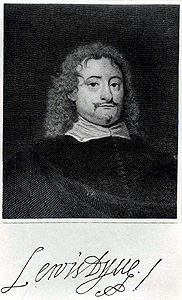 |
| http://wiki.bcw-project.org/royalist/foot-regiments/sir-lewis-dyve |
From the truly excellent BCW wiki page [clicky] - which is now become my 'go to' for all matters English Civil War we find the following interesting snippet...
"Dyve's regiment were clothed by Thomas Bushell. Coat colour deduced to be white by Peachey and Prince but not confirmed. Dyve's regiment carried yellow flags differenced by red balls in April 1644"
So two years after Edgehill we have a standard described as above, too late for me but that is what I have gone for for this regiment in light of no other facts to disprove it... There's also no date on the fact about white clothing, or when they were issued it, but that is also good enough for me..

From the same source we also learn that Sir Lewis also raised a regiment of horse of the same name...
The aforementioned Sir Lewis was an interesting fellow, and a bit of a "lad" by all accounts - I'm not sure there was any way he was ever going to be for Parliament given the little snippets of his life that I've found...

 |
| Lewis Dyve Frontispiece to the Bedfordshire Historical Record courtesy Wikipedia |
At the outbreak of the war he was part of a plan to let the forces of the King into Hull (April '42) for which his arrest was also ordered - enough was enough, and he escaped to the Continent.
He was back in England later the same year, appointed Colonel of a regiment of foot in August (when the King raised his standard at Nottingham), but commanded the troop of horse, and was wounded at the cavalry action at Powick Bridge near Worcester in the September.
In 1643, the House of Commons voted for his impeachment for High Treason for raising money for the King and for referring to Parliament as "The Pretended Parliament"
He served with Prince Rupert at the relief of Newark in 1644, and was then appointed sergeant-major-general in Dorset.
In 1645 he succeeded in storming Weymouth, but could not take neighbouring Melcombe Regis, and when the Parliamentary garrison in Melcombe succeeded in seizing the baggage train that Goring had sent to Dyve they were able to recapture Weymouth.
Dyve was captured at the siege of Sherborne, and imprisoned in the Tower of London from 1645 to 1647 when he escaped but was recaptured at Preston.

Imprisoned in Whitehall he escaped once more, according to his own account on the very day he was to have been executed, by "leaping down out of a jakes [toilet] two stories high into the Thames at high water, in the coldest of winter, and at night; so as by swimming he got to a boat that attended for him, though he was guarded by six musketeers."

Dyve went to Ireland where he once more served with the Royal forces
In 1650 he published an account of events in that country during the previous two years.

He lost much of his fortune through his loyalty to the Crown, but also in part due to heavy gambling: in 1668, the year before he died, Samuel Pepys called him disapprovingly "a great gamester"... I think I might have enjoyed a beer with him..

He married in 1624 Howarda, daughter of Sir John Strangways of Melbury House, Melbury Sampford, Dorset, and widow of Edward Rogers, by whom he had three sons and a daughter.

...once I get to three a side then it may be time for a little game..

24 figures - Peter Pig - painted March 2019
More here:
http://bedsarchives.bedford.gov.uk/CommunityArchives/Bromham/SirLewisDyve.aspx
Lastly, found this in my research... those old schoo'lers amongst us will remember Bluebear Jeff... a much missed presence..
 |
| If white and off white coats were good enough for Bluebear Jeff then they'll do for me - RIP Jeff... |

A great looking unit and I interesting history. I agree that the BCW wiki site is brilliant!
ReplyDeleteFOH - thanks and agreed re. BCW| - the first place I go to to start me off on the research
DeleteWhitecoated troops look super on the battlefield! I remember Bluebear Jeff. RIP.
ReplyDeleteThanks Jonathan - agreed.. w.r.t Jeff, bits of his memory/legacy is clearly living on in the interweb and that's no bad thing
DeleteCool looking figures
ReplyDeleteTa Neil
DeleteYou are flying with this project now Steve, great unit.
ReplyDeleteLee, it's good fun and the brushes are enthused... Sir Henry Cholmley's next!
DeleteHey Steve, not only great to see another informative post about ECW characters and their regiments, it is also great to see Jeff remembered. He was a great guy to play games with and against and I am lucky to have his entire ECW collection in my hands.
ReplyDeleteWow Codsticker - that is amazing... so you have the regiment I included at the bottom of the post? More to the point (as Napoleon would have said) are they lucky?! :o)
DeleteYes, I have that regiment. Unfortunately, they are not as "lucky" in my hands as they were in Jeff's.
DeleteNicely done ‘white’, a hard thing to get right.
ReplyDeleteCheers Norm... agreed re. white... I "highlight" with a really light grey which seems to work though it shouldn't..! :o)
DeleteWonderful work, splendid and subtile colors...
ReplyDeleteThanks Phil - much appreciated
Delete